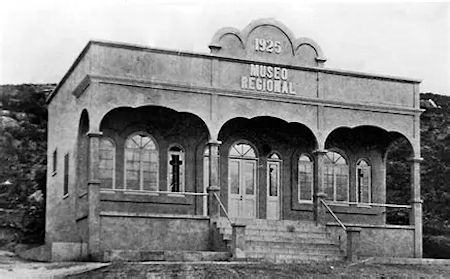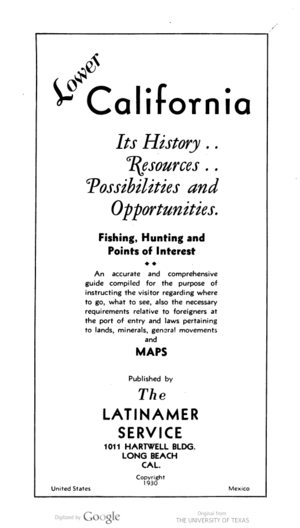 |  |
By Greg Niemann

The first museum in all of Baja California, Ensenada’s Museo Goldbaum, is celebrating its Centennial. The 100-year-old museum got its start in 1925 with a collection of relics and artifacts collected from throughout the Territory of Baja California by David Goldbaum, the man who surveyed much of the Baja peninsula.
During the latter part of the 19th century, and the early part of the 20th, ownership of land in Baja California was in a turmoil. It was hard to determine what was public land, and what was private land. Even then boundaries were mostly informal. A lot of the confusion came from the addition of large former concessions to public lands.
In hopes to colonize much of the public lands, in 1884 the Mexican government cut a deal and granted a huge concession to a newly formed Connecticut corporation to be called the International Company of Mexico.
The company principals, George H. Sisson and Luis Huller, agreed to a list of Mexican colonization guidelines and rules. For example, these included: establishing two colonies of 50 families each, setting the number of hectares per family, and much more.
With additional grants and purchases, the land eventually covered 15 million acres, from the U.S. border to the territorial border between Baja California and Baja California Sur (It included some 80 percent of all Baja California territory land, or about half the entire peninsula)).

The International Company of Mexico promoted heavily, mostly in California, and did have some success establishing a small colony in San Quintin.
However, there were numerous and varied difficulties that discouraged Huller and Sisson and they were able to unload the entire concession to a British firm (Mexican Land and Colonization Company) in 1888.
The British firm formed the Lower California Development Company, Ltd. With headquarters in Ensenada, they set out to continue the colonization. They were able to attract English settlers, but years of drought became the final catalyst and pushed the British enterprise out of business. Related lawsuits continued for years afterward.
New contracts were drawn up, and concessions extended to no avail. Following the disorder caused by the 1910 Mexican Revolution, Colonel Estaban Cantu had become territorial governor.
He wanted to develop the territory but was frustrated by the foreign colonization attempts. He convinced the Mexican government that the English company had consistently failed to live up to its colonization requirements of its land concessions. The government agreed and thus offered the company an indemnity (16 million pesos) to walk away.
A major problem remained. With the land returned to the public domain, proper boundaries were never established. While the English Company held by far the largest holdings of Baja, none of the Baja peninsula had ever been surveyed.

David Goldbaum
Governor Cantu turned to David Goldbaum, a Mexican mining engineer/surveyor living in Ensenada.
David Goldbaum (1858–1930) was born in San Blas, Mexico, in June 1858. His Jewish father, Louis Goldbaum, came from Poland (Wroclaw) in the early fifties and had settled in Mexico. His mother, Librada Valenzuela Grijalva, was from the state of Sonora.
As a young boy, David and several of his school classmates were kidnapped by the “Tiger of the Allicas,” a notorious Mexican bandit whose habit was to abduct children of wealthy parents and hold them for ransom.
Goldbaum’s father paid a heavy ransom and then sent his son to a military school in San Francisco, California. David later was graduated from the Colorado School of Mines and returned to Mexico, settling in Ensenada. He then married Carmen Padilla Diaz of Mazatlan, and they eventually had six children. During the more than 40 years Goldbaum lived in Ensenada he was involved in numerous enterprises. Aided by his fluent speaking and writing English, he was interpreter and secretary for Judge Rosario Cota, and oversaw the mining claims in the nearby areas. He also possessed several personal mining claims. In 1915 he was appointed judge of the local registry.
Then in 1917 Governor Cantu called upon him for a major surveying job. Goldbaum went out and surveyed the greater part of Lower California, submitting his 1918 report that was considered to be the most comprehensive to date.
He broke the Northern District of Baja California into 11 townships, and reported on them individually, both geographically and demographically, complete with census figures and maps. Titled “Towns of Baja California; A 1918 Report,” Goldbaum’s book and accompanying maps were instrumental in documenting much of the peninsula.

He noted a territory population of only 9,760, with about a third living in Ensenada (2,965). The other 10 towns, in descending population order in 1918: Mexicali, Tijuana, El Rosario, Tecate, El Alamo, Camalli, Santo Tomas, San Telmo, San Quintin, and Real del Castillo.
Goldbaum’s report was significant and a key source of information for other writers and historians who followed, including E.W. Nelson who wrote Lower California and its Natural Resources in 1921. Nelson referred to the map accompanying Goldbaum’s book as “the most complete yet published,” and added, “Manuscript maps from David Goldbaum have supplied the main features of the northern district.”
Peveril Meigs in Dominican Mission Frontier of Lower California (1935) cites Goldbaum’s copies of land grants, and his “carefully kept records on rainfall and crop yields.”
Goldbaum continued to travel throughout Baja and published several articles and numerous reports for the government. He went on to become a recognized author on northern Baja California exploration and minerology, traveling extensively throughout the district.
Both as an avocation and in the course of his continued surveying and engineering work, Goldbaum took numerous photos (including some of the earliest ones from the San Pedro Martir mountains), drew maps, and collected a wealth of materials including minerals, flora, fauna, Indian artifacts, fossils, and other relics of all kinds on his numerous travels around Baja.
Goldbaum became Mayor of Ensenada in 1927, a position he held until his death three years later. He was a personal friend of Presidents Porfirio Diaz, Plutarco Elías Calles, and Emilio Portes Gil, as well as Governor Abelardo Rodriguez (later President).
In 1925, Governor Rodriguez was so impressed with Goldbaum’s collection that he had a building constructed to house the numerous and varied valuable relics. It opened that year as the Museo Regional, the first museum in Baja California. Its name was later changed to Museo Goldbaum.
Some of the Goldbaum artifacts were sent to Seville, Spain for the Ibero-American Exhibition in 1930. Those relics garnered six awards, including two first place honors.
David Goldbaum, who became a popular mayor of Ensenada, died later in 1930 at the age of 71. Unfortunately, that same year following his death, the Museo, being unattended, was ransacked and much of the collections pilfered. The whereabouts of many of the pieces, collections and exhibits are unknown.
After the death of David Goldbaum, his descendants gave the property to the Government of Baja California. For a while the restored building also became a library. For years it was occupied by the Ensenada Chamber of Commerce (Canaco) and it still had some of the remaining objects on display.
Today, the building that was specifically constructed to house the Goldbaum Museum is owned by the Association of Journalists of Ensenada, A.C., a group that is in charge of its preservation, maintenance and administration and is well protected.
The Museo Goldbaum, the first museum in not only Baja California, but all of northwest Mexico, no longer features the vast collection of David Goldbaum, but still proudly stands in downtown Ensenada.

No claims but purchase was quick and simple.

I have used Baja Bound for years. Very easy and affordable.